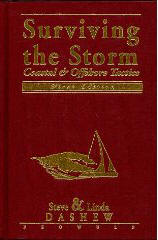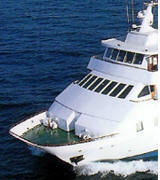|
By Michael David July 2002 Para-Anchors—Myths vs. Facts.
Many of the myths surrounding modern para-anchors derive from the
mishaps of old-time sea anchor designs. Canvas, PVC, and lightweight
Fact: Two popular American manufacturers, Fiorentino and Shewmon, construct their canopies using heavy-duty, 8 oz material. For easy storage, these anchors roll up like sleeping bags. When rolled they’re easy to drop overboard. Plus, there’s no risk of on-deck inflation. Another manufacturer, Para-Tech, founded by Victor Shane, confines their lightweight 4-ounce para-anchor inside a deployment bag to avoid such inflation.
Fact: Parachute anchors are easy to retrieve, but you need a partial trip line. Partial trip lines are designed to spin the chute and dump the water out.
Fact: If a partial trip line is tied off to a float-not to the boat- it shouldn’t tangle. Also, today’s sailors often confuse the partial trip line with the full trip line. That’s a mistake because the full trip line is secured to the boat. Full trip lines can expedite the retrieval of the para-anchor, but the top of the chute can be pulled into its shroud lines if the anchor rode stretch isn’t accounted for. This can happen as a storm volume increases. Fiorentino, Shewmon and Para-Tech, each support the use of a partial trip line in their para-anchor applications.
Fact: Fiorentino and Shewmon sew weights into one section of the canopy of their parachutes to stop rotation. Plus, Fiorentino takes an extra step by using its patented Para-Ring attachment. It stabilizes the para-anchor in breaking seas and strong ocean currents. Para-Tech addresses underwater rotation by sewing their seams inside out on every other canopy panel.
Fact: Modern para-anchors
are designed to handle tremendous abuse, even under extreme weather
situations. Fiorentino and Shewmon anchors have no reported structural
failure with their para-anchors. Para-Tech claims that published
accounts of their chutes breaking apart in rough seas are due to sailor
error and not the chute design.
Before you purchase a drag device, ask yourself:
Please click here to learn more about Sail Magazine.
|
|















